‘I Am Jaunsari’, delves into the story of Jaunsari tribe, which is perpetually at risk of losing its essence, heritage, culture, traditions, and landscape
| Photo Credit: Special Arrangement
Every migration carries a story of how and why a family or a community of people moved or were displaced from their home to a new one. In the early 1980s, when Nitin Joshi’s family migrated from their ancestral home in Uttarakhandnestled in the hills of the western Himalayas, it left a sense of emptiness within the family.
A Pune-based documentary photographer and storyteller , Nitin decided from a young age to return to his roots, learn about his homeland, reconnect with his heritage, and one day, shed light on his community through his craft.

A Jaunsari woman from Jaunsar-Bawar region of Uttarakhand.
| Photo Credit:
Special Arrangement
Nitin’s poignant photographic exhibition, titled ‘I Am Jaunsari’, delves into the story of his own tribe, which is perpetually at risk of losing its essence, heritage, culture, traditions, and landscape. “I began documenting the Jaunsaris in 2014 because I want to eventually publish a book about my tribe. I was born in Chhatau village, located in Chakrata tehsil of Dehradun district, Uttarakhand, and raised in New Delhi, where my father relocated for work in the 1980s. This documentation is deeply personal to me, as I, too, am a migrant,” says Nitin, whose life has bridged two contrasting worlds: the serene, timeless landscapes of his ancestral home and the relentless pace of urban life.
Nitin’s photographs are a deeply personal exploration of identity, belonging, and the enduring connection between people and their land. The subjects in his images are his neighbours and relatives—those who chose to remain in the hills, steadfastly preserving their way of life.

Children from Nitin Joshi’s village in Uttarakhand.
| Photo Credit:
Special Arrangement
Uttarakhand is home to five major identified tribes: the Bhotias, Tharus, Buxas, Jaunsaris, and Rajis. The Jaunsari community resides in the Jaunsar-Bawar region of Uttarakhand, part of the Garhwal division and bordering Himachal Pradesh. Traditionally, the Jaunsaris have been agriculturists, practising terraced farming to cultivate crops such as wheat, barley, and lentils, while also raising sheep and goats.
Over time, the traditions and culture of the Jaunsari tribe have seen a gradual decline. For Nitin, chronicling their journey through his photography was a way to honour and preserve the fading essence of this community and their unique way of life.
“Documenting the community is a small step towards addressing the identity crisis that the Jaunsari tribe faces today. Through my photographs, I bring to light the stories of elders who remain steadfast in their villages, preserving customs and landscapes, while the younger generation migrates to cities in search of better opportunities. The photographs also celebrate the beauty and resilience of the tribe as it navigates the delicate balance between tradition and modernity.”

Nitin Joshi’s family migrated from their ancestral home in Uttarakhandnestled in the hills of the western Himalayas.
| Photo Credit:
Special Arrangement
Each frame is steeped in nostalgia and reverence, inviting viewers to reflect on their own connections to their origins, says Nitin. “This exhibition is more than just a documentation of the Jaunsari tribe; it is a celebration of heritage and an urgent reminder of the fragility of cultural identities in an era of rapid modernisation,” he says, adding “My photographs are an attempt to inspire viewers to pause, reflect, and cherish the roots that define us before they fade into memory.”
‘I Am Jaunsari’ will run from January 29 to February 4 from 11 am to 7 pm at Jehangir Art Gallery.
Published – January 28, 2025 03:37 pm IST